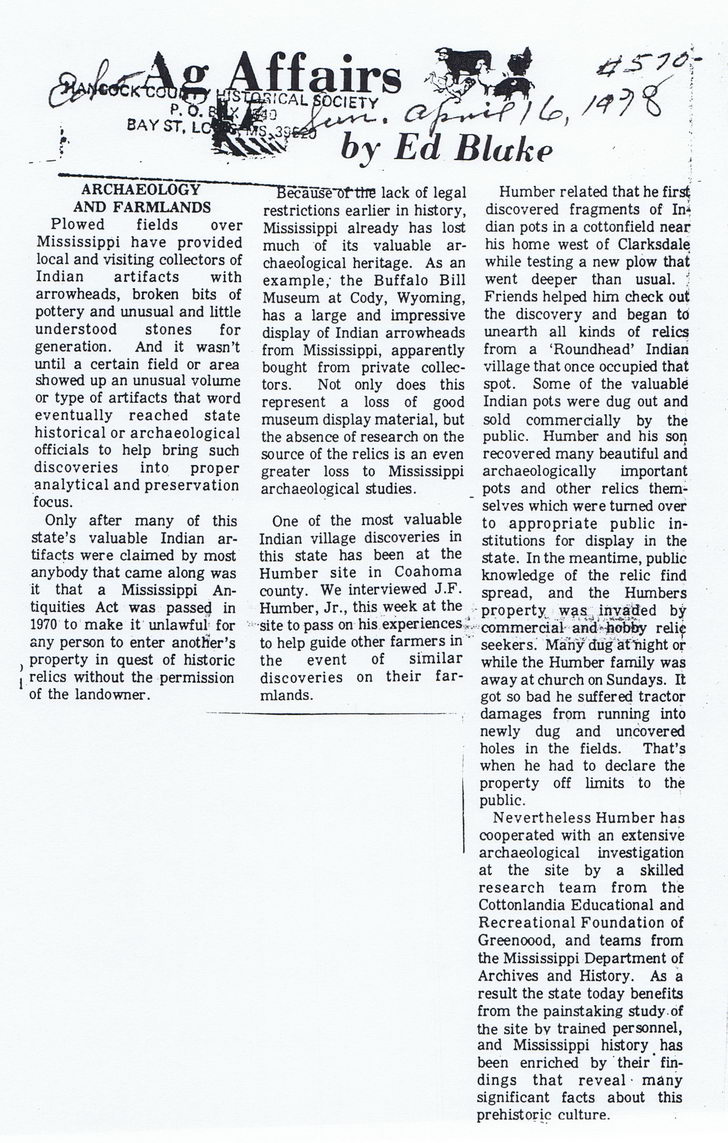This text was obtained via automated optical character recognition.
It has not been edited and may therefore contain several errors.
ARCHAEOLOGY AND FARMLANDS Plowed fields over Mississippi have provided local and visiting collectors of Indian artifacts with arrowheads, broken bits of pottery and unusual and little understood stones for generation. And it wasn?t until a certain field or area showed up an unusual volume or type of artifacts that word eventually reached state historical or archaeological officials to help bring such discoveries into proper analytical and preservation focus. Only after many of this state?s valuable Indian artifacts were claimed by most anybody that came along was it that a Mississippi Antiquities Act was passed in 1970 to make it unlawful for any person to enter another?s property in quest of historic relics without the permission of the landowner. T3ecauseT>f'ttte lack of legal restrictions earlier in history, Mississippi already has lost much of its valuable archaeological heritage. As an example,' the Buffalo Bill Museum at Cody, Wyoming, has a large and impressive display of Indian arrowheads from Mississippi, apparently bought from private collectors. Not only does this represent a loss of good museum display material, but the absence of research on the source of the relics is an even greater loss to Mississippi archaeological studies. One of the most valuable Indian village discoveries in this state has been at the Humber site in Coahoma county. We interviewed J.F. Humber, Jr., this week at the site to pass on his experiences ,? to help guide other farmers in the event of similar discoveries on their farmlands. Humber related that he first discovered fragments of In* dian pots in a cottonfield near his home west of Clarksdale while testing a new plow that went deeper than usual. ; Friends helped him check out the discovery and began to unearth all kinds of relics from a ?Roundhead? Indian village that once occupied that spot. Some of the valuable Indian pots were dug out and sold commercially by the public. Humber and his son recovered many beautiful and archaeologically important pots and other relics themselves which were turned over to appropriate public institutions for display in the state. In the meantime, public knowledge of the relic find spread, and the Humbers property^ was^ invaded by commercial and-hobby reli? seekers. Many dug affright or while the Humber family was away at church on Sundays. It got so bad he suffered tractor damages from running into newly dug and uncovered holes in the fields. That?s when he had to declare the property off limits to the public. Nevertheless Humber has cooperated with an extensive archaeological investigation at the site by a skilled research team from the Cottonlandia Educational and Recreational Foundation of Greenoood, and teams from the Mississippi Department of Archives and History. As a result the state today benefits from the painstaking study, of the site bv trained personnel, and Mississippi history has been enriched by their findings that reveal ? many significant facts about this prehistoric culture.

Engman Color-001